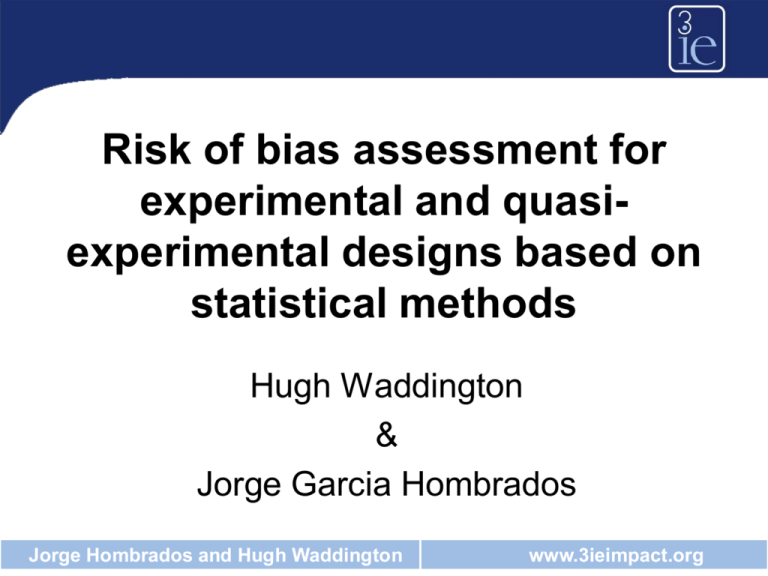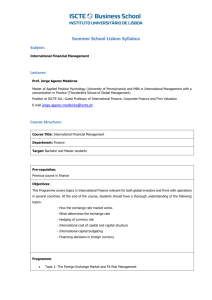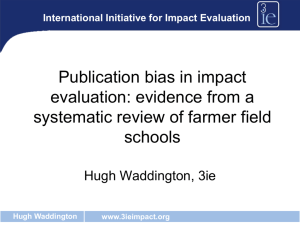Risk of bias assessment for experimental and quasi
advertisement

Risk of bias assessment for experimental and quasiexperimental designs based on statistical methods Hugh Waddington & Jorge Garcia Hombrados Jorge Hombrados and Hugh Waddington www.3ieimpact.org “The haphazard way we individually and collectively study the fragility of inferences leaves most of us unconvinced that any inference is believable... It is important we study fragility in a much more systematic way” Edward Leamer, 1983: Let’s take the con out of econometrics Jorge Hombrados and Hugh Waddington www.3ieimpact.org Important elements of study quality • Internal validity – Asks about the causal properties • External validity – Asks about the generalizability of causal properties (or, more generally, the study‟s findings) • Construct validity – Asks about the language of the measures • Statistical conclusion validity – Asks about the assumptions, estimations, and calculations of summary statistics Jorge Hombrados and Hugh Waddington www.3ieimpact.org E.g. Systematic review by Gaarder et al. “CCTs and health: unpacking the causal chain” Journal of Development Effectiveness, 2010 Many applications to CCT programmes Programme Method (authors) Brazil (Bolsa Familia) PSM (Morris et al 2004) Colombia (Familias en Accion) PSM, DID (Attanasio et al 2005) Honduras (PRAF) RCT (Flores et al 2004; Morris et al 2004) Jamaica (PATH) RDD (Levy and Ohls 2007) Malawi (MDICP) RCT (Thornton 2008) Mexico (Progresa, Oportunidades) RCT (Gertler, 2000 etc etc etc), also PSM, RDD, DID Nepal (SDIP) ITS (Powell-Jackson et al 2009) Nicaragua (RPS) RCT (Barham, Maluccio, Flores 2008) Paraguay (Tekopora) PSM (Soares et al 2008) Turkey (CCT) RDD (Ahmed et al 2006) Jorge Hombrados and Hugh Waddington www.3ieimpact.org Jorge Hombrados and Hugh Waddington www.3ieimpact.org Existing risk of bias tools • 100s of risk of bias tools exist (Deeks et al. 2003) • Mainly designed for assessing validity of RCTs and „epidemiological‟ designs (controlled before and after designs, cohort designs, case-control designs) • But do not enable assessment of QEDs commonly used in social enquiry, such as RDDs and IV estimation Jorge Hombrados and Hugh Waddington www.3ieimpact.org Prominent tools Risk of bias tool AHRQ Cochrane tool CEBP Down & Black EPOC EPPHP NICE SIGN 50 RCTs QuasiRCTs √ √ ? ? √ √ ? ? √ √ √ √ ? ? ? ? √ ? Natural experime nt (RDD) Instrume ntal variables Matching (eg PSM) Diff-indiff (panel data) CBA Casecontrol √ √ √ √ √ √ √ √ √ √ √ √ √ √ √ √ √ Wells Valentine & Cooper (DIAD) Cohort √ Jorge Hombrados and Hugh Waddington √ √ www.3ieimpact.org These tools also - Do not enable consistent classification across the full range of studies (experimental and quasi-experimental) - Can lead to overly simplistic and inappropriate classification of risk of bias across quasi-experiments - Are not sufficiently detailed to evaluate the execution of the methods of analysis, including complex statistical procedures - Often do not evaluate appropriate risk of bias criteria for social experiments Jorge Hombrados and Hugh Waddington www.3ieimpact.org Theory and evidence on QEDs • Overall, the evidence on international development suggests that high quality quasi-experimental studies based on statistical methods yield comparable results to experiments • This seems to be particularly the case when evaluators have knowledge about the allocation rule, and so can model it, or the allocation rule is exogenous (Cook, Shadish and Wong, 2008; Hansen et al. 2011) • But theory and evidence also suggests that if they are not appropriately implemented, these designs can yield misleading results (e.g. Glazerman et al., 2003) • We should focus on identifying the circumstances under which these approaches yield accurate causal inference Jorge Hombrados and Hugh Waddington www.3ieimpact.org So a tool like MSMS is not appropriate Source: Sherman et al. 1998 Jorge Hombrados and Hugh Waddington www.3ieimpact.org Internal validity of QEDs • Impact evaluation assignment based on: – Randomised assignment (experimental studies) – Exogenous variation (natural experiments and RDDs) – Selection by planners and or self-selection by participants • Risk of bias of quasi-experimental designs largely depends on: – The validity of the technique to ensure group equivalence – The implementation of the method – Other factors such as spillovers/contamination, hawthorne effects Jorge Hombrados and Hugh Waddington www.3ieimpact.org Principles for assessing RoB (Higgins et al. 2011) • Do not use quality scales • Focus on internal validity • Assess risk of bias in results not quality of reporting • Assessment requires judgement • Choose domains based on a combination of theoretical and empirical considerations • Report outcome specific risk of bias Jorge Hombrados and Hugh Waddington www.3ieimpact.org And we would add: • Assessment should be based on both study design, as well as execution of the design and analysis • Ideally will provide a common framework for evaluation of risk of bias for different types of designs Jorge Hombrados and Hugh Waddington www.3ieimpact.org RoB tool being developed • Build in the structure and RoB concept of existing tools including CEBP, EPOC and Cochrane. • Address the statistical and conceptual assumptions underpinning the validity of quasi-experimental designs based on statistical methods. • Provide a common framework of 8 evaluation criteria for the assessment of risk of bias and confidence levels (internal validity) in impact evaluation using experimental and the quasi-experimental designs based on statistical methods. Jorge Hombrados and Hugh Waddington www.3ieimpact.org Evaluation criteria Category bias 1. Mechanism of assignment / identification Selection bias For experimental designs: is the allocation mechanism appropriate to generate equivalent groups? Does the model of participation capture all relevant observable and unobservable differences in covariates between groups? 2. Group equivalence in implementation of the method Confounding Is the method of analysis adequately executed? Are the observable results of the counterfactual identification process convincing? Are all likely relevant confounders taken into account in the analysis? Is the estimation method sensitive to nonrandom attrition? 3. Hawthorne effects Motivation bias Are differences in outcomes across groups influenced by participant motivation as a result of programme implementation and, or monitoring? 4. Spill-overs and cross-overs Performance bias Is the programme influencing the outcome of the individuals in the control group (including compensating investments for control groups)? 5. Selective methods of analysis Analysis reporting bias Is the method of analysis or specification model used by the author selectively chosen? Is the analysis convincingly reported (and available for replication)? 6. Other sources of bias Other biases Jorge Hombrados and Hugh of Relevant questions Are the results of the study subject to other threats to validity (e.g. placebo effects, Waddingtoncourtesy bias, survey www.3ieimpact.org effects, inadequate Full internal validity assessment will also take account of 7. Confidence Intervals and significance of the effect Type I and Type II error. Is the study subject to a unit of analysis error not adequately accounted for? Is the study subject to heteroscedasticity not accounted for? Is the study not taking into account possible heterogeneity in effects? Are the lack of significant effects driven by a lack of power? Jorge Hombrados and Hugh Waddington www.3ieimpact.org Mechanism of assignment • There are other credible methods identification than randomisation. of • However, some study designs (RDDs, longitudinal studies) and methods of analysis (IV) are better able to eliminate or account for unobservables than others (PSM, crosssectional regression). – E.g. Miguel and Kremer (2004) Worms ?? Jorge Hombrados and Hugh Waddington www.3ieimpact.org Assumption of assignment mechanisms Method Validity assumption Randomised control trial (RCT) Regression discontinuity design (RDD) Assignment /participation rule external to participants and effectively random (observables and unobservables balanced) „Natural experiment‟ (instrumental variables) Difference-in-differences (DID) regression Adjusts for time-invariant unobservables; assumes no timevarying unobservables Propensity score matching (PSM) Assumes unobservables are correlated with observables Jorge Hombrados and Hugh Waddington www.3ieimpact.org Group equivalence: execution of method of analysis • Internal validity relies heavily on the execution of the method of analysis (e.g. group equivalence, efficiency of the participation equation, appropriateness of the instrumental variable); • While a degree of qualitative judgment is required for all methods, it is particularly apparent in QEDs. Jorge Hombrados and Hugh Waddington www.3ieimpact.org Threats to validity in execution • RCTs: insufficient observations, non-random attrition – E.g. high attrition in Miguel & Kremer (2004) Worms • DID: attrition, failure to control for time varying covariates in DID regression – Farmer field schools eg Orozco-Cirilo, 2008 • PSM: lack of covariate balance – DANIDA (2012) covariate imbalance • RDD: „fuzzy‟ discontinuity • IV: exogeneity of instrument – Duflo and Pande (2009) „Dams‟ – instrument not exogenous Jorge Hombrados and Hugh Waddington www.3ieimpact.org Spillovers and other forms of contamination • Non-geographically clustered designs (when they should be) eg worms, mosquito nets, sanitation etc • Differential contamination by compensatory intervention (which affects outcome) • „Survey effects‟ (measurement as treatment) – E.g. Deworming trials (Taylor Robinson et al. 2012) – E.g. WASH and diarrhea studies (Kremer et al. 2009) Jorge Hombrados and Hugh Waddington www.3ieimpact.org Hawthorne & John Henry effects • Motivation bias caused by implementation and evaluation monitoring can explain differences in outcomes in intervention studies. • In contrast, expectation (placebo) effects are embodied within the causal mechanisms of many social interventions, so that isolating them may be less relevant (and in many cases is in any case not possible) • E.g. interventional vs. observational data • Intensive forms of data collection (cf. WASH and child diarrhoea Ies) Jorge Hombrados and Hugh Waddington www.3ieimpact.org Selective methods of analysis • The method of analysis used in the IE should be the ‘best’ (likely least biased) given the available research design • We recognise the importance of theory-based exploratory research tradition in the social sciences. But statistical methods when used inappropriately can provide ample opportunities for biased results-based research – E.g. Pitt and Khandkher (1998) in Bangladesh – construction of outcomes – Ricker-Gilbert (2008) in Bangladesh: uses 2-step Heckman model, but presents non-significant IMR coefficient – Carlberg (2012) in Ghana: no IV identifiers are significant, and no test presented for exogeneity Jorge Hombrados and Hugh Waddington www.3ieimpact.org Precision of the effect • Misinterpretation of statistical (confidence interval) due to: significance • Heterogeneity of effects (eg binomial distribution of outcome) • Heteroschedasticity and lack of normality • Unit of analysis errors (allocation at village, analysis at household level) • Lack of statistical power (small sample size) Jorge Hombrados and Hugh Waddington www.3ieimpact.org Options for „summary‟ risk of bias • Reviewer judgement to determine most important domains to determine high and low risk of bias, preferably specified in protocol – E.g. for highly subjective outcomes, blinding more important – Some outcomes at less risk of unobservable selection bias than others e.g. time savings resulting from access to amenities – White (2008) – In other other cases, unobservable selection bias is particularly problematic (e.g. microfinance due to risk aversion) • Independent double coding and inter-rater check • Examine sensitivity of results to risk of bias status Jorge Hombrados and Hugh Waddington www.3ieimpact.org Thank you Visit: www.3ieimpact.org http://www.campbellcollaboration.org/interna tional_development/index.php Jorge Hombrados and Hugh Waddington www.3ieimpact.org






